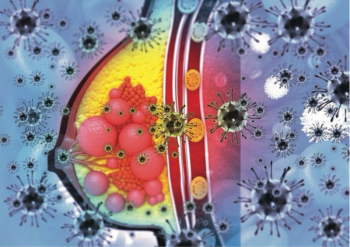
Next-Generation Test Shows Sensitivity/Specificity in Pancreatic Cancer
The blood test showed consistent, strong results in high-risk subgroups such as those with familial history, pancreatic cysts, or diabetes.
A next-generation pancreatic cancer blood test elicited positive results, detecting significantly more cancers than CA19-9 in patients with pancreatic cancer in the VERIFI study, according to a press release from Immunovia.1
The test detected 77% of stage I and II pancreatic cancer, which exceeded the study’s target goal of 65% (P = .005); it also improved over the sensitivity of CA19-9, a common biomarker for pancreatic cancer, which had a detection rate of 69% (P = .0126).2 The specificity rates were 88% with the blood test and 89% with CA19-9.
The specificity of the test was 88%, which did not exceed the pre-defined success criteria of 90%. Reasons cited for this included a much smaller cohort of control patients; CA19-9 levels in VERIFI controls being different than the CLARITI study’s controls; and VERIFI including a higher percentage of patients with pancreatic cysts, who are harder to diagnose.
Across various high-risk patient subgroups, the blood test showed “excellent and consistent” sensitivity and specificity: overall (n = 317), the sensitivity was 78%, and the specificity was 92%; in the group with familial history or genetic risk (n = 71), the sensitivity was 78%, and the specificity was 94%; in the group with diabetes (n = 128), the sensitivity was 80%, and the specificity was 90%; and in the group with cysts (n = 79), the sensitivity was 72%, and the specificity was 89%.
Data came from the VERIFI and CLARITI validation studies, and full results were shared in a company webcast.2
“The Immunovia test accurately classified cancerous and non-cancerous blood samples in the VERIFI study,” Jeff Borcherding, chief executive officer at Immunovia, stated in the press release.1 “The test once again significantly outperformed CA19-9. In addition, combined results from the CLARITI and VERIFI studies make it clear that our next-generation test can accurately detect pancreatic cancer in multiple different groups of high-risk individuals.”
The VERIFI study compared a total of 385 rare blood samples, 115 of whom had stage I and II pancreatic ductal adenocarcinoma (PDAC) and 270 of whom made up the high-risk, non-cancerous control group.
The primary end point of the VERIFI study was sensitivity, defined as the ability to detect stage I and II PDAC in the case samples. Secondary end points included specificity, defined as whether the test correctly classified the control samples as non-cancerous, and performance vs CA19-9, defined as whether the blood test provided higher sensitivity than CA19-9 at equal specificity.
The CLARITI study was the first successful clinical trial to evaluate Immunovia’s pancreatic cancer blood test.
CA19-9 elicited a sensitivity of 66% in the overall group (P <.001), 66% in the familial/genetic group (P = .0114), 72% in the diabetes group (P = .0075), and 62% in the cysts group (P = .0047). The CA19-9 specificity rates were 93%, 94%, 89%, and 93% (P = .0093), respectively. The Immunovia blood test was superior in all values except for overall specificity and cysts, where it was inferior, and familial/genetic specificity, where it was equal.
Regarding detection of stage I and II pancreatic cancer, historical control data have shown that endoscopic ultrasound had a sensitivity of 100% and a specificity of 82%, MRI had a sensitivity of 50% and a specificity of 91%, and CT had a sensitivity of 50% and a specificity of 86%.3,4
These results will be used to support regulatory submissions and payer reimbursement efforts.
References
- Immunovia provides further positive data from the VERIFI study of its next-generation pancreatic cancer test. News release. Immunovia. March 24, 2025. Accessed March 25, 2025. https://tinyurl.com/njjnwff4
- VERIFI validation study results review. Immunovia. March 24, 2025. Accessed March 25, 2025. https://tinyurl.com/ywterafp
- Sakamoto H, Kitano M, Suetomi Y, Maekawa K, Takeyama Y, Kudo M. Utility of contrast-enhanced endoscopic ultrasonography for diagnosis of small pancreatic carcinomas. Ultrasound Med Biol. 2008;34(4):525-532. doi:10.1016/j.ultrasmedbio.2007.09.018
- Borbath I, Van Beers BE, Lonneux M, et al. Preoperative assessment of pancreatic tumors using magnetic resonance imaging, endoscopic ultrasonography, positron emission tomography and laparoscopy. Pancreatol. 2005;5(6):533-561. doi:10.1159/000087497
Newsletter
Stay up to date on recent advances in the multidisciplinary approach to cancer.

















































































